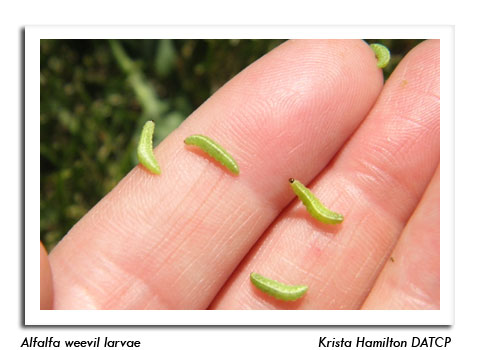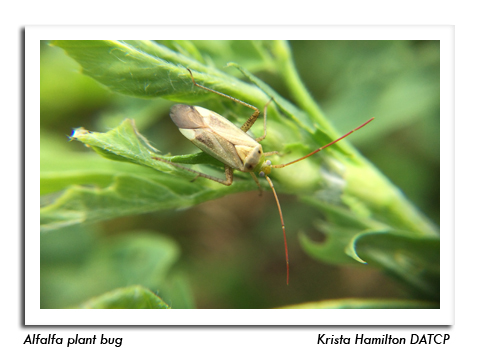
 |
|
|
Forages & Grains
Volume 64 Number 7 Date 06/13/2019 ALFALFA WEEVIL - Larval counts have been low in first-crop alfalfa. Surveys in Clark, Marathon, Portage, and Waupaca counties on June 10 and 11 found no more than 10% leaf tip feeding and 0.6 larvae per sweep, with an average of 0.2 per sweep. In fact, sampling of 200 first-crop fields since late May yielded an overall average of just 0.25 per sweep, or 25 per 100 sweeps. Leaf tip feeding has not exceeded 20% in any field checked by DATCP this spring. The peak weevil damage period would normally occur from 600-800 degree days (base 48°F), but nearly all fields will have been harvested before the lower range of this threshold is reached. PLANT BUG - Nymphs are now more abundant than the adults in most fields. Counts for the week ending June 13 were less than one per sweep and averaged 0.3 per sweep, which is very low in comparison to the 5.0 per sweep economic threshold. POTATO LEAFHOPPER - Surveys in the north-central and central areas found low counts of 0.02-0.5 leafhoppers per sweep in remaining first-crop fields. Economic populations of 1.0 per sweep for alfalfa 8-11 inches and 2.0 per sweep for fields 12 inches or taller have not been recorded by DATCP surveyors as of June 13. PEA APHID - Densities are typical for early June at approximately 2-4 aphids per sweep, with a few exceptional fields having higher counts of 10-20 per sweep. Counts of this level are far below the 100-per-sweep threshold for alfalfa. The appearance of winged aphids in the past two weeks signals that scouting should begin in pea fields, where the threshold is much lower at 35 aphids per sweep or two per plant. For alfalfa, harvesting fields on time is usually the most effective aphid control. -- Krista Hamilton, DATCP Entomologist 




|
|
|